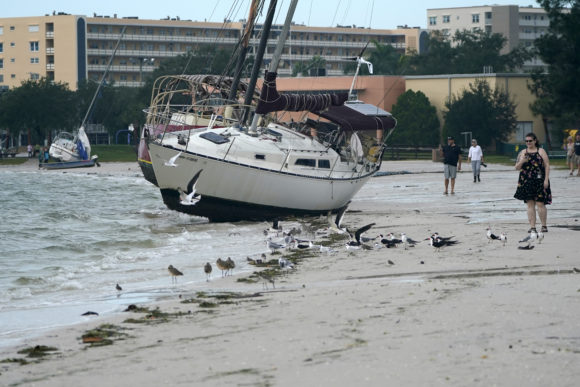After hanging over Florida for several days, the former Tropical Storm Eta became a post-tropical cyclone early Friday, racing off the Southeast Atlantic coast and bringing heavy rains and gusty winds to the Carolinas after blustering across north Florida.
One death in Florida was linked to the storm, along with some scattered flooding as the system finally started a path offshore of South Carolina over the weekend that took it further out to sea.
Once it reached the Carolinas Thursday, the storm system triggered flash flooding, multiple water rescues and road closures, and at least one collapsed bridge in South Carolina, said Sandy LaCourte, a meteorologist with the National Weather Service in Greenville, South Carolina.
Some parts of the Carolinas saw three to seven inches (7.5 to 17 centimeters) of rainfall already by Thursday afternoon with more expected. That came amid a combination of moisture from the Gulf of Mexico being carried up by a cold front that had pushed Eta across Florida earlier.
Although it was not the most powerful storm to hit the U.S. this year, Eta had broad impacts across the Tampa Bay region on Florida’s Gulf Coast, buffeting an area of more than 3.5 million people with gusty winds and rain.
In Bradenton Beach, Florida, Mark Mixon stepped into his flooded garage as he was laying sandbags around his home Wednesday evening and was electrocuted, said Jacob Saur, director of public safety for Manatee County. There were appliances plugged into the garage and Mixon was killed when he stepped into the water, Saur said.
The storm earlier forced the closure of some lanes of Tampa Bay bridges because of storm surge but they began reopening Thursday. Also reopened was the Sunshine Skyway Bridge in the region.
Earlier, firefighters in Tampa had to rescue around a dozen people who got stuck in storm surge flooding on a boulevard adjacent to the bay. Some vehicles remained on the roadway Thursday. Isolated neighborhoods also experienced enough flooding to evacuate.
Several sailboats broke free from their moorings and washed ashore in Gulfport, Florida, including the vessel where Mo Taggart has lived for two years with her dog. She thinks the boat is a total loss.
“I mean, it was disaster,” Taggart said. “I mean, I came out here. My boat’s just up against the seawall, just smashing, smashing … I need to get another boat. I want to be back on the water, (my dog) wants to be back on the water.”
The storm had made an earlier landfall in South Florida on Sunday after lashing Central America and Mexico with deadly force. Before that first brush with Florida, Eta first hit Nicaragua as a Category 4 hurricane and killed at least 120 people in Central America and Mexico, with scores more missing.

It was the 28th named storm of a busy Atlantic hurricane season, tying the 2005 record for named storms.
This extraordinarily busy season has focused attention on climate change, which scientists say is causing wetter, stronger and more destructive storms.
___
Frisaro reported from Fort Lauderdale, Florida. Associated Press photographer Lynne Sladky and video reporter Cody Jackson contributed to this report from Pinellas County and AP reporter Michelle Liu contributed from Columbia, S.C.
Topics Florida Catastrophe Natural Disasters Windstorm Flood South Carolina Mexico
Was this article valuable?
Here are more articles you may enjoy.


 Coverage Needed: Hundreds of Thousands in SE Now in Flood Zones With New Maps
Coverage Needed: Hundreds of Thousands in SE Now in Flood Zones With New Maps  As Rates Rise, Majority of Homeowners Say Insurance Industry Is in Crisis: Survey
As Rates Rise, Majority of Homeowners Say Insurance Industry Is in Crisis: Survey  Supreme Court Overturns Chevron Rule in Blow to Regulators
Supreme Court Overturns Chevron Rule in Blow to Regulators  Big ‘I’ Report: Independent Agency Channel Placed 62% of Premiums in 2023
Big ‘I’ Report: Independent Agency Channel Placed 62% of Premiums in 2023 

